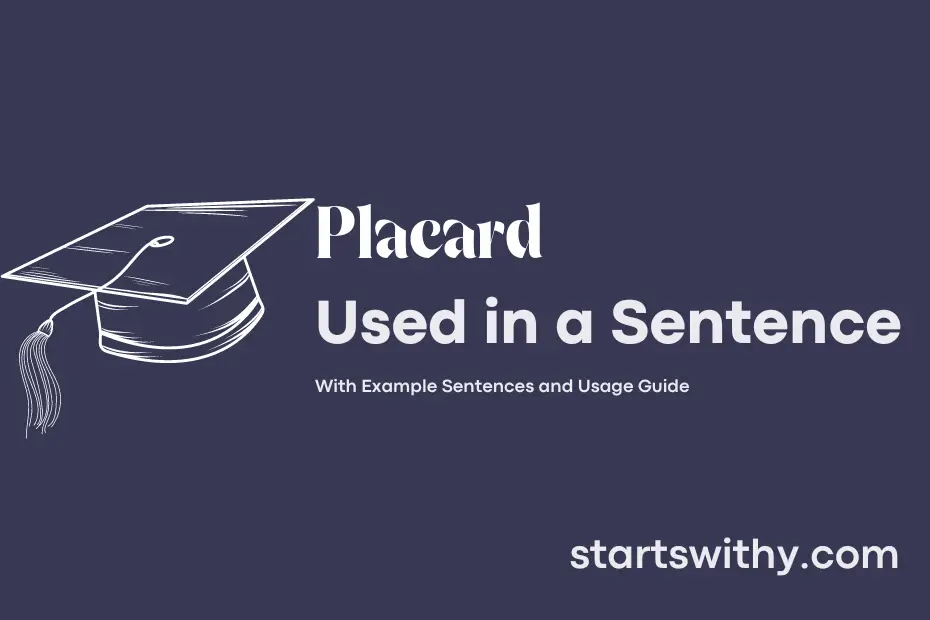Have you ever come across the word “placard” and wondered what it means? A placard is a sign or poster displayed in a public place for advertising or information purposes.
Often used for promotional or instructional messages, placards can be seen in various settings such as shops, events, or on transportation vehicles. Now, let’s explore the concept of placards further and delve into how they effectively convey messages to the public.
7 Examples Of Placard Used In a Sentence For Kids
- Placard has important information on it.
- Bring your placard to show and tell.
- Teacher uses a placard to teach us new words.
- We can make a colorful placard for our classroom.
- Look at the big placard on the wall.
- Point to the placard with the number “2” on it.
- Let’s make a placard with our names on it.
14 Sentences with Placard Examples
- Placard with the schedule for upcoming exams can be found near the college notice board.
- Students were holding placards with slogans during a protest against fee hikes.
- The student council representative carried a placard with the results of the election.
- In the library, there is a placard indicating the designated quiet study areas.
- The cafeteria had a placard displaying the menu for the day’s special.
- For the cultural fest, volunteers were creating placards with event details to put up around the campus.
- The student union members were waving placards at the rally to raise awareness about environmental issues.
- A placard near the entrance reminded students to wear masks and maintain social distancing.
- During the college fair, each department had a placard with information about courses offered.
- A placard in the auditorium listed the guest speakers for the seminar on career opportunities.
- The student leader held up a placard with a quote from Gandhi during a discussion on non-violent protest methods.
- At the scholarship announcement ceremony, winners were led to the stage by holding a placard with their names.
- During the sports day, each team had a placard with their mascot and team name.
- The student club placed a placard outside their meeting room inviting new members to join.
How To Use Placard in Sentences?
Placard is a versatile word that can be used in various contexts to convey a message. When using placard in a sentence, it is important to keep in mind its meaning as a noun, which refers to a sign or notice for public display. Here is a simple guide on how to use placard correctly:
-
Identify the need for a sign or notice to display information publicly.
-
Choose the appropriate message or information that you want to convey using the placard.
-
Begin your sentence with Placard to indicate that the message is being displayed on a sign. For example, “Placard warning: Wet floor.”
-
Follow the word Placard with the specific message you want to display. For instance, “Placard for sale: Cars and motorcycles.”
-
Make sure to use proper punctuation and capitalize the first letter of the message following Placard.
-
Consider the placement of the placard in your sentence and ensure it flows naturally.
By following these simple steps, beginners can effectively incorporate Placard into their sentences to communicate messages clearly and effectively. Practice using placard in different contexts to become more comfortable with its usage.
Conclusion
In conclusion, sentences with the keyword “placard” have been effectively utilized to convey messages or information on public displays. Whether written by protesters advocating for change, shopkeepers advertising their products, or organizers directing event attendees, placards have been integral in communicating varied purposes succinctly. These concise sentences serve as powerful tools in capturing attention, expressing opinions, and guiding individuals towards specific actions.
The versatility of sentences with placards is evident in their ability to spark awareness, provoke thought, and incite action in a visually compelling manner. Whether calling for social justice, promoting products, or providing directions, these sentences play a crucial role in conveying information efficiently and effectively to a wide audience. Their impact on public spaces and events further emphasizes the importance of clear, concise messaging in capturing attention and influencing responses.



